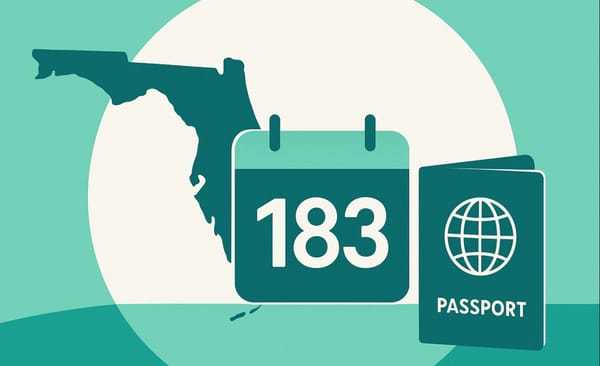How to Move to Spain from the US?

When you think about your dream lifestyle, what do you imagine? Perhaps sunny afternoons sipping Rioja in a cobblestone plaza, exploring world-famous museums, or savoring the Mediterranean diet in a bustling mercado.
Or maybe it’s the relaxed pace of life, incredible diversity of landscapes—from beaches and mountains to vibrant cosmopolitan cities—and the unmatched quality of healthcare and infrastructure.
Whatever your vision of an ideal lifestyle, there’s a strong chance Spain offers exactly what you’re looking for.
Spain isn’t just another European destination—it’s consistently rated one of the best countries for quality of life, healthcare, and overall happiness. For American expats, Spain provides an ideal balance of vibrant culture, affordability, safety, and easy access to travel throughout Europe.
But let’s be real: moving abroad, especially to a place known for its labyrinthine bureaucracy, can seem daunting. Visas, taxes, residency requirements—it can feel overwhelming. Luckily, you’re not alone. Thousands of Americans have successfully made Spain their new home, and you can too.
We’ll break down all the critical information clearly and simply so you can confidently make your move.
Ready to learn exactly how to move to Spain from the U.S.?
Let’s dive in.
Move to Spain from America: Start with a Tourist Stay (The Schengen 90/180 Rule)
Before diving head-first into visas and long-term residency plans, your first step should be spending some quality time in Spain as a tourist. Think of it as a “test drive” for your new life—this initial visit is crucial for understanding what you love about Spain, and perhaps just as importantly, what you don’t.
Spain offers vastly different lifestyles depending on where you settle. Madrid buzzes with cosmopolitan energy, Barcelona blends coastal charm with creative vibes, Valencia offers affordability and perfect beaches, while Andalusia draws expats with its sunny climate and relaxed pace.
Southern Spain, especially popular destinations like the Costa del Sol, is renowned for its warm climate, relaxed Mediterranean lifestyle, and vibrant expat communities.
Then there are the stunning Balearic and Canary Islands—perfect for those dreaming of island living. Across all these regions, the unique aspects of Spanish culture—regional traditions, lively festivals, and daily customs—shape the experience and are a major attraction for expatriates.
Making the most of your scouting trip:
- Stay at least a month if possible. Living day-to-day will give you a genuine sense of local life.
- Try multiple regions. Even a week in two or three distinct areas can clarify your preferences.
- Explore different neighborhoods, comparing life in the city center versus outlying areas to see which environment suits you best.
- Rent an Airbnb or serviced apartment rather than hotels. Cooking at home and shopping locally will immerse you in daily routines. Consulting a local real estate agent can also help you understand the rental market and legal requirements for foreigners.
Understanding the Schengen 90/180 rule:
As a US citizen from a non-EU country, you can enter Spain (and any other Schengen country) under the visa waiver program for up to 90 days within any 180-day period. This visa waiver allows short stays without a visa, but you must comply with the Schengen 90/180 rule:
- 90 days max stay, then you must leave Schengen area for at least 90 days before returning.
- The 90-day clock starts the moment you first enter any Schengen country, not just Spain.
- Overstaying can lead to serious problems, including fines or future travel restrictions.
Note: Starting in 2024, US citizens and other non-EU country nationals will need to obtain an ETIAS entry authorization as part of the visa waiver process before traveling to Spain or the Schengen Area.
Can you extend your stay?
Generally, Schengen rules don’t allow extensions beyond the 90 days without applying for a long-term visa from outside Spain. However, some U.S. visitors strategically alternate their stays with non-Schengen European countries (like the UK, Croatia, Albania, or Turkey) or consider other European countries as alternative destinations to remain in Europe longer while respecting the rules.
What to do during your visit:
- Explore neighborhoods: Walkable, lively barrios versus quiet residential areas—each offers a different lifestyle.
- Check amenities: Look into local grocery stores, public transport, gyms, parks, and cafés.
- Test internet speeds: Especially critical if you’re considering remote work.
- Visit in different seasons: Experiencing winter vs. summer can dramatically impact your impression of a region.
Taking some time to start learning Spanish during your scouting trip will help you integrate more easily and navigate daily interactions, making your transition smoother.
Your initial scouting trip isn’t just a vacation—it’s the foundation of your new life in Spain. By investing the time upfront to experience various locations and lifestyles thoroughly, you’ll make smarter decisions about your long-term move.
Ready to stay longer? Let’s explore the different visas that allow you to make Spain your new home.

Choosing the right Spanish visa and residency permit
Selecting the right visa is crucial—it impacts your taxes, work rights, and your pathway to permanent residency. For citizens moving to Spain from the US, several visa options are available, such as non-lucrative, student, and digital nomad visas, each with specific visa requirements.
Understanding the visa process—including documentation, application steps, and timing—is essential to move to Spain from America successfully.
Here’s a detailed breakdown of key visas for U.S. expats:
Digital Nomad Visa (Teletrabajo Internacional)
This visa is perfect for remote workers employed by companies or clients outside Spain. Digital nomad visa holders can also work with Spanish clients, but this work should not exceed 20% of their total professional activity.
Who it’s for:
Remote W-2 employees (salaried) or 1099 freelancers (independent contractors).
Key requirements:
- Monthly income of at least €2,368 (200% of Spain’s minimum wage).
- Employment history or client relationship of at least 3 months.
- Proof that your employer or clients are established abroad for at least 1 year.
- Private health insurance valid in Spain.
- “Highly qualified” criteria: either a university degree or 3+ years professional experience.
Duration:
Initial 1-year visa, renewable up to 3-year permits.
Why choose this:
Ideal if you work remotely for non-Spanish companies or clients and seek legal residency without changing employment setup.
Critical Distinctions (W-2 vs. 1099):
W-2 Employees (U.S. salaried workers):
- Must provide a letter from your employer explicitly allowing remote work from Spain.
- Must present a “Certificate of Coverage” from the U.S. Social Security Administration (SSA), proving ongoing Social Security contributions in the U.S. (currently challenging to obtain).
- Recent practical experience shared by applicants on Reddit indicates approvals can occur if the employer actively assists with SSA documentation.
1099 Freelancers (Independent contractors):
- Generally experience smoother application processes.
- Required to register as “autónomo” (self-employed) upon arrival in Spain, fulfilling Social Security obligations easily.
- Documentation involves client contracts, invoices, and bank statements proving consistent income.
Practical advice from recent applicants:
- W-2 applicants: Coordinate closely with your employer for SSA certification or Spanish Social Security registration.
- Freelancers: Typically experience fewer obstacles. Consider switching from W-2 to 1099 status if possible for greater simplicity.
- Recent approvals of U.S. W-2 cases suggest improvements in SSA flexibility, but many applicants find the freelancer route far more straightforward.
Non-Lucrative Residence Visa
The non lucrative visa, also known as a popular retirement visa option for Americans, is ideal for retirees or individuals with passive income who don’t plan to work in Spain. Applicants must demonstrate sufficient funds to qualify for Spanish residency and obtain a residence permit.
Who it’s for:
Retirees or those with passive income sources (investments, pensions, savings).
Key requirements:
- Proof of financial means (~€30,000 annually per person).
- No local employment permitted.
- Private health insurance valid in Spain.
Duration:
Initial 1-year residency, renewable every 2 years.
Why choose this:
Ideal for retirees or those with stable passive income sources looking for long-term residency without working locally.
Highly Qualified Professional Visa (EU Blue Card)
For executives and specialists, the Highly Qualified Professional Visa is a type of work visa designed for highly skilled professionals seeking employment in Spain. This visa allows foreign professionals to live and work legally in Spain, provided they meet specific requirements.
Key requirements: The work visa application process requires a valid job offer from a Spanish employer, who must initiate the application and provide a legally binding employment contract. Applicants must also demonstrate their qualifications and experience relevant to the position.
Who it’s for:
High-skilled executives, specialists, or researchers with employment offers in Spain.
Key requirements:
- Specialized role or managerial position.
- Salary around €45,000+ annually.
- University degree or significant professional experience.
Duration:
Initial 2-year permit, renewable in 2-year increments.
Why choose this:
Suitable for professionals and managers seeking a streamlined, fast-track visa with employment secured in Spain.
Self-Employed (Autónomo) Visa
For entrepreneurs and freelancers seeking to work independently in Spain, the self employment visa is a popular option. This visa allows you to legally reside and operate your own business in Spain.
Key requirements:
- Submit a detailed business plan outlining your proposed activities.
- Demonstrate sufficient financial means to support yourself.
- In many cases, applicants may need to register a Spanish company as part of their business plan.
- Obtain any necessary professional qualifications or licenses relevant to your field.
Who it’s for:
Freelancers, entrepreneurs, or independent contractors planning to operate a local business or professional practice.
Key requirements:
- Detailed business plan.
- Proof of capital.
- Private health insurance valid in Spain.
Duration:
Initial 1-year residency, renewable every 2 years.
Why choose this:
Ideal if you intend to establish and operate your own business or freelance locally.
Entrepreneur / Startup Visa
Who it’s for:
Entrepreneurs with innovative, tech-oriented startups or businesses.
Key requirements:
- Innovative business plan approved by Spanish economic authorities.
- Clear economic or social value to Spain.
- Adequate funding or capital backing.
Duration:
Initial 1-year residency, renewable every 2–3 years.
Why choose this:
Best suited for entrepreneurs with innovative business ideas contributing positively to Spain’s economy.
Student Visa
Allows residence for accredited studies.
Who it’s for:
Students enrolled full-time in accredited educational programs or language courses.
Key requirements:
- Proof of enrollment.
- Financial sufficiency (~€600/month).
- Private health insurance valid in Spain.
Duration:
The duration matches your educational program length, which is renewable annually.
Why choose this:
Ideal for those looking to study long-term in Spain, with opportunities to transition later into other residence types.
How to choose your visa:
- Purpose: Remote work, retirement, entrepreneurship, studying?
- Income: Ensure clear documentation proving income meets thresholds.
- Social Security: Understand obligations clearly, especially critical for W-2 remote employees.
- Long-term goals: Permanent residency or citizenship?
Understanding and fulfilling the unique documentation and social security requirements for each visa, especially distinguishing between W-2 and 1099 setups for digital nomads, will significantly streamline your relocation to Spain.

Spanish visa application process
After selecting the visa best suited to your goals, the next critical step is navigating Spain’s visa application process. Here’s a clear, practical breakdown to guide you smoothly through each stage:
Step 1: Gather essential documents
Regardless of your chosen visa, the core documents typically required include:
- Passport valid for at least one year.
- Visa Application Form (Formulario Nacional-D).
- Passport-sized photographs (two recent color photos).
- Criminal background check (FBI clearance for U.S. applicants, apostilled and translated into Spanish).
- Medical certificate (confirming no serious communicable diseases).
- Proof of financial means (bank statements, employment letter, or client contracts).
- Proof of private health insurance or private insurance (valid in Spain with full coverage and no copayments).
- Proof of accommodation (lease agreement or initial accommodation booking).
- Evidence of professional qualifications or employment (degree certificate, contracts, or employment letters).
Step 2: Translate and Apostille Documents
- All official documents (background checks, medical certificates, birth/marriage certificates, educational degrees, company incorporation documents) must be translated into Spanish by a certified translator.
- Apostille certification is mandatory for all official documents originating in the U.S. (contact your state’s Secretary of State office or authorized agencies for apostilles).
Step 3: Schedule your consulate appointment
- Book your appointment well in advance through your nearest Spanish consulate in the U.S. (each consulate has jurisdiction over specific states—check carefully).
- Appointments fill quickly, especially in major cities, so schedule as soon as you start collecting documents.
Step 4: Submit application and pay fees
- Attend your consulate appointment in person.
- Submit your documents, pay the application fee (typically between $140–$200 USD, depending on visa type), and provide biometric data (fingerprints and photograph).
- Consular officers may briefly interview you about your plans in Spain, financial stability, and visa choice.
Step 5: Wait for visa approval
- Typical visa processing times range from 30 to 90 days, depending on your chosen visa:
- Digital Nomad and Highly Qualified visas often have faster processing (30–60 days).
- Non-Lucrative and Entrepreneur visas typically take closer to 60–90 days.
- The consulate may request additional documents or clarification—respond quickly to avoid delays.
Step 6: Receive your visa and move to Spain
- Once approved, your visa will usually be valid for 90 days (to enter Spain). Some visas, such as the Digital Nomad Visa, initially grant a one-year stay.
- Arrange your travel plans carefully—once in Spain, you must complete additional steps promptly.
Step 7: Complete essential steps after arrival in Spain
Upon arrival, you must finalize your residency status within 30 days. These steps are essential for securing Spanish residency and obtaining your residence permit:
- Obtain your NIE (Número de Identidad de Extranjero): Essential for banking, renting property, and most official processes.
- Register for your TIE (Tarjeta de Identidad de Extranjero): Your physical residency card and proof of your residence permit.
- Register your residence address (Empadronamiento): Done at your local town hall; this proves your official residence location and is essential for many administrative purposes related to residence permits.
- Register with Social Security (if applicable, especially important for Digital Nomad Visa holders).
Step 8: Plan for renewals and residency extensions
- Visas typically require renewal after an initial 1–2 years. Prepare documentation (financial proofs, continued residency, tax compliance) well ahead of time.
- Track and document your days spent outside Spain to comply with residency requirements (usually fewer than 183 days annually abroad).
Now that your visa application process is clear, let’s explore the next vital topic: how your residency impacts taxation and financial planning as a U.S. expat in Spain.
Taxes in Spain for U.S. Expats
Effectively managing taxes is crucial for U.S. expats in Spain. You must navigate both Spanish and American tax obligations. Here’s a detailed breakdown to help you understand your responsibilities and optimize your financial position:
Tax Residency in Spain
You are considered a tax resident if you meet certain criteria:
- You reside in Spain more than 183 days per year.
- Your primary economic interests or family home is in Spain.
Spanish tax residents pay taxes on worldwide income.
Spain’s Income Tax (IRPF)
Progressive rates from 19% to 47% depending on income.
Typical Income Tax Brackets:
- Up to €12,450: 19%
- €12,451–€20,200: 24%
- €20,201–€35,200: 30%
- €35,201–€60,000: 37%
- €60,001–€300,000: 45%
- Above €300,000: 47%
Beckham Law (Régimen Especial de Impatriados)
A special regime for qualified professionals relocating to Spain:
- Flat rate of 24% on income up to €600,000 per year.
- Valid up to six years.
- Attractive for digital nomads, executives, and relocated employees.
Additional Taxes in Spain
Wealth Tax
- Applies if net wealth exceeds €700,000.
- Rates range from 0.2% to 3.5%.
Capital Gains Tax
Progressive rates of 19%–28%.
Modelo 720
Annual declaration of foreign assets exceeding €50,000.

U.S. tax obligations while living in Spain
Federal Income Tax Returns
Mandatory annual filing, reporting all worldwide income.
Foreign Earned Income Exclusion (FEIE)
The FEIE allows qualifying U.S. expats to exclude a certain amount of foreign-earned income from U.S. taxation. For 2023, this exclusion amount is up to $126,500.
To qualify, you must meet one of the following tests:
- Physical Presence Test: You’ve spent at least 330 full days in Spain (or another foreign country) during any 12-month period.
- Bona Fide Residence Test: You’ve spent at least 330 full days in Spain (or another foreign country) during any 12-month period.
To claim the FEIE, file Form 2555 with your U.S. tax return.
Example: If you earn $80,000 working in Spain, you can exclude the entire amount using the FEIE, leaving you with no U.S. taxes owed on that income.

Foreign Tax Credit (FTC)
The FTC allows you to offset your U.S. tax liability with the taxes you’ve paid to Spain. This credit works dollar-for-dollar, which is especially useful if Spain’s taxes are higher than U.S. taxes.
Example: If you owe $10,000 in Spanish taxes and $8,000 in U.S. taxes, the FTC can cancel out your U.S. tax bill entirely.

FBAR & FATCA Reporting
- FBAR required if foreign account balances exceed $10,000.
- FATCA requires filing IRS Form 8938 if foreign assets exceed certain thresholds.
Social Security Benefits
- Always taxable by the U.S.; not covered by FEIE.
- U.S.-Spain Totalization Agreement prevents double taxation on social security contributions.
State Taxes
- Possible continued state taxes depending on domicile.
- Establish residency in a tax-friendly state (e.g., Florida, Texas).

Additional U.S. Tax Considerations
- Retirement accounts: distributions from IRAs/401(k)s typically taxable.
- Avoid PFICs (Foreign mutual funds/ETFs) due to severe tax penalties.
Annual deadlines
Spain:
- IRPF filing: April–June.
- Modelo 720: by March 31.
U.S.:
- Federal Tax Returns: April 15 (extensions available).
- FBAR: April 15 (automatic extension to October 15).










